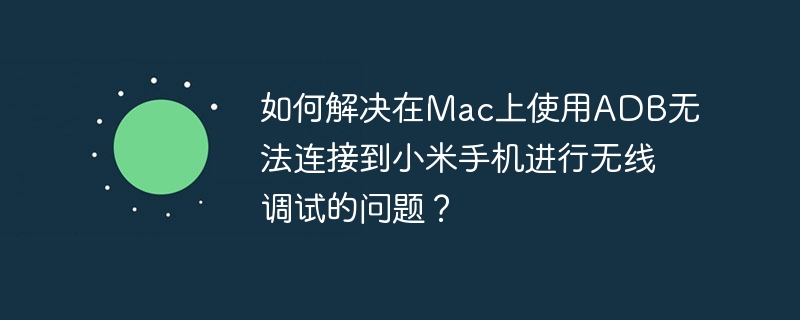用JavaScript實(shí)現(xiàn)粒子系統(tǒng)可以通過(guò)以下步驟:1. 創(chuàng)建粒子類,定義粒子的屬性和行為。2. 實(shí)現(xiàn)粒子系統(tǒng)類,管理粒子的生成、更新和繪制。3. 使用canvas api進(jìn)行繪制,并通過(guò)requestanimationframe實(shí)現(xiàn)動(dòng)畫(huà)循環(huán)。4. 添加高級(jí)特性如顏色、旋轉(zhuǎn)、碰撞檢測(cè)等。5. 優(yōu)化性能,包括限制粒子數(shù)量和使用canvas的全局合成操作。6. 增加用戶交互,如通過(guò)點(diǎn)擊生成粒子。這個(gè)方法展示了如何從基礎(chǔ)到高級(jí)實(shí)現(xiàn)一個(gè)動(dòng)態(tài)且高效的粒子系統(tǒng)。

讓我們深入探討如何用JavaScript實(shí)現(xiàn)一個(gè)粒子系統(tǒng)吧。
要實(shí)現(xiàn)一個(gè)粒子系統(tǒng),我們首先需要理解粒子系統(tǒng)的基本概念:它是一系列小元素(粒子)在屏幕上移動(dòng)、變化的視覺(jué)效果。粒子系統(tǒng)常用于模擬火、煙、水、雪等自然現(xiàn)象,或者創(chuàng)造出動(dòng)態(tài)的背景效果。
在JavaScript中實(shí)現(xiàn)粒子系統(tǒng),我們可以利用html5的Canvas API來(lái)繪制和動(dòng)畫(huà)化粒子。Canvas提供了一個(gè)強(qiáng)大的平臺(tái),讓我們能夠以高效的方式在網(wǎng)頁(yè)上繪制圖形。
立即學(xué)習(xí)“Java免費(fèi)學(xué)習(xí)筆記(深入)”;
讓我們從一個(gè)簡(jiǎn)單的粒子系統(tǒng)開(kāi)始吧。以下是一個(gè)基本的實(shí)現(xiàn):
// 粒子類 class Particle { constructor(x, y) { this.x = x; this.y = y; this.vx = Math.random() * 2 - 1; // 隨機(jī)水平速度 this.vy = Math.random() * 2 - 1; // 隨機(jī)垂直速度 this.radius = Math.random() * 3 + 1; // 隨機(jī)半徑 this.alpha = 1; // 初始透明度 } update() { this.x += this.vx; this.y += this.vy; this.alpha -= 0.01; // 逐漸消失 } draw(ctx) { ctx.beginPath(); ctx.arc(this.x, this.y, this.radius, 0, Math.PI * 2); ctx.fillStyle = `rgba(255, 255, 255, ${this.alpha})`; ctx.fill(); } } // 粒子系統(tǒng)類 class ParticleSystem { constructor() { this.particles = []; } addParticle(x, y) { this.particles.push(new Particle(x, y)); } update() { this.particles = this.particles.filter(p => p.alpha > 0); this.particles.forEach(p => p.update()); } draw(ctx) { this.particles.forEach(p => p.draw(ctx)); } } // 初始化Canvas const canvas = document.getElementById('canvas'); const ctx = canvas.getContext('2d'); canvas.width = window.innerWidth; canvas.height = window.innerHeight; const system = new ParticleSystem(); // 動(dòng)畫(huà)循環(huán) function animate() { ctx.clearRect(0, 0, canvas.width, canvas.height); system.update(); system.draw(ctx); // 每幀添加新粒子 system.addParticle(Math.random() * canvas.width, Math.random() * canvas.height); requestAnimationFrame(animate); } animate();
這個(gè)實(shí)現(xiàn)展示了一個(gè)基本的粒子系統(tǒng),其中粒子會(huì)隨機(jī)生成、移動(dòng)并逐漸消失。讓我們深入探討一下這個(gè)實(shí)現(xiàn)的各個(gè)方面。
粒子系統(tǒng)的核心是Particle類,它定義了每個(gè)粒子的屬性和行為。每個(gè)粒子有位置(x, y)、速度(vx, vy)、半徑和透明度(alpha)。update方法更新粒子的位置和透明度,draw方法使用Canvas API繪制粒子。
ParticleSystem類管理所有粒子。它有一個(gè)particles數(shù)組來(lái)存儲(chǔ)所有活躍的粒子。addParticle方法添加新的粒子,update方法更新所有粒子并移除透明度為0的粒子,draw方法繪制所有粒子。
動(dòng)畫(huà)循環(huán)使用requestAnimationFrame來(lái)確保平滑的動(dòng)畫(huà)效果。每幀我們清空Canvas,然后更新和繪制粒子系統(tǒng)。同時(shí),每幀我們還添加新的粒子,以保持系統(tǒng)的活躍性。
這個(gè)實(shí)現(xiàn)雖然簡(jiǎn)單,但已經(jīng)展示了粒子系統(tǒng)的基本原理。讓我們進(jìn)一步探討一些高級(jí)用法和優(yōu)化技巧。
首先,我們可以添加更多的粒子屬性和行為。例如,我們可以讓粒子有顏色、旋轉(zhuǎn)、加速度等。我們還可以實(shí)現(xiàn)粒子之間的交互,比如碰撞檢測(cè)和反應(yīng)。
class Particle { constructor(x, y) { this.x = x; this.y = y; this.vx = Math.random() * 2 - 1; this.vy = Math.random() * 2 - 1; this.radius = Math.random() * 3 + 1; this.alpha = 1; this.color = `hsl(${Math.random() * 360}, 100%, 50%)`; // 隨機(jī)顏色 this.rotation = Math.random() * Math.PI * 2; // 初始旋轉(zhuǎn) this.rotationSpeed = Math.random() * 0.1 - 0.05; // 旋轉(zhuǎn)速度 } update() { this.x += this.vx; this.y += this.vy; this.alpha -= 0.01; this.rotation += this.rotationSpeed; } draw(ctx) { ctx.save(); ctx.translate(this.x, this.y); ctx.rotate(this.rotation); ctx.beginPath(); ctx.arc(0, 0, this.radius, 0, Math.PI * 2); ctx.fillStyle = `rgba(${this.color}, ${this.alpha})`; ctx.fill(); ctx.restore(); } }
這個(gè)版本的粒子類添加了顏色和旋轉(zhuǎn)效果,使得粒子系統(tǒng)更加生動(dòng)有趣。
在性能優(yōu)化方面,我們需要注意幾點(diǎn):
- 粒子數(shù)量:粒子數(shù)量越多,性能壓力越大。我們可以根據(jù)設(shè)備性能動(dòng)態(tài)調(diào)整粒子數(shù)量。
- 繪制優(yōu)化:我們可以使用Canvas的globalCompositeOperation屬性來(lái)實(shí)現(xiàn)一些特殊效果,同時(shí)減少繪制次數(shù)。
- 內(nèi)存管理:我們需要確保及時(shí)清理不再需要的粒子,避免內(nèi)存泄漏。
class ParticleSystem { constructor(maxParticles = 1000) { this.particles = []; this.maxParticles = maxParticles; } addParticle(x, y) { if (this.particles.length p.alpha > 0); this.particles.forEach(p => p.update()); } draw(ctx) { ctx.globalCompositeOperation = 'lighter'; // 疊加模式 this.particles.forEach(p => p.draw(ctx)); } }
這個(gè)版本的粒子系統(tǒng)類添加了最大粒子數(shù)量的限制,并使用了globalCompositeOperation來(lái)實(shí)現(xiàn)更有趣的視覺(jué)效果。
在實(shí)際應(yīng)用中,我們還需要考慮用戶交互。例如,我們可以讓用戶通過(guò)鼠標(biāo)點(diǎn)擊來(lái)生成新的粒子,或者通過(guò)觸摸事件在移動(dòng)設(shè)備上實(shí)現(xiàn)類似的效果。
canvas.addEventListener('click', (e) => { const rect = canvas.getBoundingClientRect(); const x = e.clientX - rect.left; const y = e.clientY - rect.top; for (let i = 0; i <p>這個(gè)代碼片段展示了如何通過(guò)鼠標(biāo)點(diǎn)擊生成新的粒子,增加了用戶交互的趣味性。</p><p>總的來(lái)說(shuō),JavaScript實(shí)現(xiàn)的粒子系統(tǒng)是一個(gè)非常靈活和強(qiáng)大的<a style="color:#f60; text-decoration:underline;" title="工具" href="https://www.php.cn/zt/16887.html" target="_blank">工具</a>。我們可以通過(guò)添加更多的粒子屬性、優(yōu)化性能、增加用戶交互來(lái)創(chuàng)造出各種各樣的視覺(jué)效果。希望這個(gè)深入的探討能幫助你更好地理解和實(shí)現(xiàn)自己的粒子系統(tǒng)。</p>
.jpg)
















.png)
